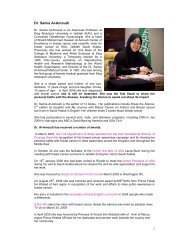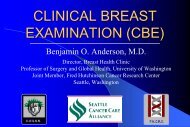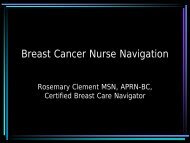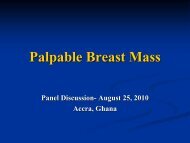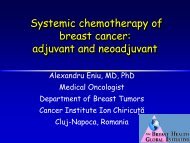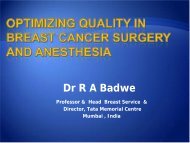The role of breast cancer civil society in different ... - ResearchGate
The role of breast cancer civil society in different ... - ResearchGate
The role of breast cancer civil society in different ... - ResearchGate
Create successful ePaper yourself
Turn your PDF publications into a flip-book with our unique Google optimized e-Paper software.
G. Azenha et al. / <strong>The</strong> Breast 20 (2011) S81eS87 S83Table 2Organizational Features and Program Activities <strong>of</strong> NGOs Work<strong>in</strong>g <strong>in</strong> the BreastCancer Arena by Country Income Classification.NGO Organizational andProgram Featuresmedical services (53%), emotional support (44%), and basic materialprovision (41%). For NGOs <strong>in</strong> upper-middle <strong>in</strong>come countries,<strong>in</strong>formation (76%), community awareness (76%), early detectioncampaigns (76%), emotional support (60%), and basic materialprovision (44%) were the most common programmatic activities.Lastly, the most common program activities for NGOs <strong>in</strong> high<strong>in</strong>come countries were <strong>in</strong>formation (75%), community awareness(54%), early detection campaigns (52%), emotional support (50%),research (48%), and advocacy (46%).DiscussionWorld Bank Country Income Classification(2009)LowIncomeLowereMiddleIncomeUppereMiddleIncomeBreast <strong>cancer</strong> <strong>civil</strong> <strong>society</strong> <strong>in</strong> low and lower-middle <strong>in</strong>comecountriesHighIncomen ¼ 10 n ¼ 34 n ¼ 62 n ¼ 48Organizational FeaturesHealth care pr<strong>of</strong>essional founded 7 (70%) 23 (68%) 25 (40%) 15 (31%)Breast <strong>cancer</strong> survivor founded 3 (30%) 12 (35%) 33 (53%) 33 (69%)Hospital Associated 5 (50%) 12 (35%) 5 (8%) 5 (10%)Type <strong>of</strong> organization focusGeneral health 5 (50%) 12 (35%) 7 (11%) 1 (2%)General <strong>cancer</strong> 1 (10%) 10 (29%) 25 (40%) 18 (38%)Breast <strong>cancer</strong>-specific 4 (40%) 12 (35%) 30 (48%) 29 (60%)Coalition 1 (10%) 2 (6%) 4 (6%) 7 (15%)Advocacy coalition 0 (0%) 1 (3%) 4 (6%) 7 (15%)Program ActivityInformation 10 (100%) 22 (65%) 47 (76%) 36 (75%)Community awareness 9 (90%) 26 (76%) 47 (76%) 26 (54%)Early detection campaigns 8 (80%) 24 (71%) 47 (76%) 25 (52%)Direct medical services 6 (60%) 18 (53%) 16 (26%) 5 (10%)Emotional support 4 (40%) 15 (44%) 37 (60%) 24 (50%)Research 4 (40%) 5 (15%) 6 (10%) 23 (48%)Basic material provision 3 (30%) 14 (41%) 27 (44%) 14 (29%)Advocacy 3 (30%) 9 (26%) 19 (31%) 22 (46%)F<strong>in</strong>ancial support 1 (10%) 9 (26%) 12 (19%) 9 (19%)Legal rights 0 (0%) 0 (0%) 14 (23%) 17 (35%)*Bold <strong>in</strong>dicates top programs.NGOs <strong>in</strong> low <strong>in</strong>come and lower-middle <strong>in</strong>come countries werefound to be broadly similar <strong>in</strong> terms <strong>of</strong> organizational features andprogram emphases. In low <strong>in</strong>come and lower-middle <strong>in</strong>comecountries, the few <strong>breast</strong> <strong>cancer</strong>-specific NGOs that exist tend to besmall, limited-capacity organizations with limited geographicreach. Often NGOs and <strong>breast</strong> <strong>cancer</strong> programs are established byhealth care pr<strong>of</strong>essionals specializ<strong>in</strong>g <strong>in</strong> the disease, frustrated withthe dimension <strong>of</strong> the problem and conv<strong>in</strong>ced that a greater societalresponse is needed. Breast <strong>cancer</strong>-specific NGOs <strong>in</strong> low and lowermiddle<strong>in</strong>come countries are <strong>of</strong>ten hospital-based, serv<strong>in</strong>g thepatients access<strong>in</strong>g the few (or only) <strong>breast</strong> <strong>cancer</strong> treatment facilitiesexistent <strong>in</strong> the country. Active <strong>breast</strong> <strong>cancer</strong> programs are alsoevident <strong>in</strong> reproductive health NGOs and general health NGOs,where <strong>breast</strong> <strong>cancer</strong> is <strong>in</strong>corporated as part <strong>of</strong> a larger women’shealth agenda and <strong>of</strong>ten coupled to cervical <strong>cancer</strong> <strong>in</strong>itiatives.In these lower resource sett<strong>in</strong>gs, <strong>breast</strong> <strong>cancer</strong> <strong>civil</strong> <strong>society</strong>programs typically focus on rais<strong>in</strong>g disease awareness, <strong>of</strong>fer<strong>in</strong>g<strong>in</strong>formation, provid<strong>in</strong>g direct medical services, and early detectioncampaigns. Emotional support programs are also present amongmany NGOs. Emotional support programs typically follow a grouppeer-support model where <strong>breast</strong> <strong>cancer</strong> survivors speak to womenrecently diagnosed with the disease, shar<strong>in</strong>g experiences andcreat<strong>in</strong>g small survivor communities. Basic material provisions arealso important given the limited <strong>breast</strong> <strong>cancer</strong> services available;NGOs <strong>of</strong>ten provide basic patient service programsdmanag<strong>in</strong>gbanks <strong>of</strong> wigs, prosthesis and post-mastectomy brasdand <strong>in</strong> somecases provide f<strong>in</strong>ancial support for patients to cover out-<strong>of</strong>-pockettreatment expenses.NGOs typically take advantage <strong>of</strong> their community presence andrun community-based awareness programs educat<strong>in</strong>g <strong>in</strong>dividualsabout <strong>breast</strong> <strong>cancer</strong>, signs, symptoms, and survivability. Suchprograms are aimed at break<strong>in</strong>g down the prevalent myths andmisconceptions about the disease through promotion <strong>of</strong> <strong>breast</strong>health education, <strong>breast</strong> self-exam<strong>in</strong>ation (BSE) and the importance<strong>of</strong> early detection. In discrete cases, given the medical leadership,screen<strong>in</strong>g services may be <strong>of</strong>fered under special <strong>in</strong>itiatives.In low <strong>in</strong>come and lower-middle <strong>in</strong>come countries <strong>breast</strong> <strong>cancer</strong>is <strong>of</strong>ten equated to a death sentence due to the bleak prognosisassociated with <strong>breast</strong> <strong>cancer</strong> late presentation (70% <strong>of</strong> <strong>breast</strong><strong>cancer</strong>s <strong>in</strong> low-resource sett<strong>in</strong>gs are diagnosed <strong>in</strong> advancedstages). 10 A <strong>breast</strong> <strong>cancer</strong> fatalism cycle (Fig. 1) is observed where<strong>breast</strong> <strong>cancer</strong> stigma and fatalism lead to late diagnosis <strong>in</strong> thepopulation (with patients present<strong>in</strong>g late out <strong>of</strong> fear <strong>of</strong> be<strong>in</strong>gdiagnosed with a term<strong>in</strong>al disease). This results <strong>in</strong> limited numbers<strong>of</strong> women surviv<strong>in</strong>g <strong>breast</strong> <strong>cancer</strong> and few survivors to put a publicface to their <strong>breast</strong> <strong>cancer</strong> story and give hope to others, which <strong>in</strong>turn propagates the stigma, fatalism and fear. In such situations,<strong>breast</strong> <strong>cancer</strong> <strong>civil</strong> <strong>society</strong> is work<strong>in</strong>g primarily to break this cycleby seed<strong>in</strong>g survivor community networks to empower women tospeak up about the disease and to <strong>of</strong>fer hope to others. In do<strong>in</strong>g so,<strong>civil</strong> <strong>society</strong> organizations attempt to reduce <strong>in</strong>dividual barriers toearly detection and diagnosis and dissem<strong>in</strong>ate the notion that<strong>breast</strong> <strong>cancer</strong> is curable.Low <strong>in</strong>come and lower-middle <strong>in</strong>come countries were found toshare the programmatic emphases described above but did havesome differences. <strong>The</strong> data suggests that f<strong>in</strong>ancial support wasmore common among NGOs <strong>in</strong> lower-middle <strong>in</strong>come countriesthan <strong>in</strong> low <strong>in</strong>come countries. Information and research were muchmore important program areas <strong>in</strong> low <strong>in</strong>come countries comparedto lower-middle <strong>in</strong>come countries. <strong>The</strong> differences <strong>in</strong> research maybe l<strong>in</strong>ked to the greater number <strong>of</strong> hospital associated NGOs <strong>in</strong> thelow <strong>in</strong>come sample, or perhaps a product <strong>of</strong> sample bias due to lownumbers <strong>in</strong> this <strong>in</strong>come group.Late diagnosisFatalism,fear, andstigmaFig. 1. Breast <strong>cancer</strong> fatalism cycle.FewsurvivorsFewsurvivorswill<strong>in</strong>g toshare theirstory
S84G. Azenha et al. / <strong>The</strong> Breast 20 (2011) S81eS87Table 3Examples <strong>of</strong> NGO Breast Cancer Programs <strong>in</strong> Low Income Countries.Community Awareness and InformationdTanzania<strong>The</strong> Medical Women Association <strong>of</strong> TanzaniaFounder: Health care pr<strong>of</strong>essionals.Collaborator: Public health association <strong>of</strong> Tanzania.Activities: Educates journalists and dissem<strong>in</strong>ates evidence-based <strong>cancer</strong><strong>in</strong>formation to <strong>in</strong>crease public awareness on common <strong>cancer</strong>s <strong>in</strong> Tanzania(<strong>in</strong>clud<strong>in</strong>g <strong>breast</strong> and cervical <strong>cancer</strong>s), break<strong>in</strong>g down myths andmisconceptions and promot<strong>in</strong>g health-seek<strong>in</strong>g behaviors.Direct ServicesdGhanaBreast Care InternationalFounder: Specialist <strong>in</strong> <strong>breast</strong> pathology.Collaborator: Peace and Love Hospital.Activities: Counsel<strong>in</strong>g center (help dispel myths about <strong>breast</strong> <strong>cancer</strong>; connectssurvivors with newly diagnosed patients) and education (<strong>breast</strong> <strong>cancer</strong> andBSE); CBE center and mammography and treatment center.For examples <strong>of</strong> specific NGO programs and activities <strong>in</strong> low<strong>in</strong>come and lower-middle <strong>in</strong>come countries see Tables 3 and 4,respectively.Breast <strong>cancer</strong> <strong>civil</strong> <strong>society</strong> <strong>in</strong> upper-middle <strong>in</strong>come countriesIn upper-middle <strong>in</strong>come countries, where resources exist butaccess is <strong>in</strong>equitable, <strong>breast</strong> <strong>cancer</strong> NGOs exist and <strong>civil</strong> <strong>society</strong>empowers patients by provid<strong>in</strong>g <strong>in</strong>formation, rais<strong>in</strong>g awareness,and address<strong>in</strong>g <strong>in</strong>dividual, community and structural barriers tocare. A more significant survivor community promotes a moreTable 4Examples <strong>of</strong> NGO Breast Cancer Programs <strong>in</strong> Lower-Middle Income Countries.Early Detection Campaigns, Information, and Direct ServicesdThailandQueen Sirkit Center for Breast CancerFounder: Breast surgeon.Collaborators: Community leaders.Activities: Breast <strong>cancer</strong> survivors work with <strong>breast</strong> nurse counselors andgynecology nurses to visit Bangkok slums, liais<strong>in</strong>g with community leaders toteach <strong>breast</strong> and cervical <strong>cancer</strong> awareness and <strong>of</strong>fer CBE and cervical <strong>cancer</strong>screen<strong>in</strong>gs.Survivor Support and Early DetectiondPhilipp<strong>in</strong>esICanServeFounder: High pr<strong>of</strong>ile journalist <strong>breast</strong> <strong>cancer</strong> survivor.Collaborator: Mayor <strong>of</strong> Marik<strong>in</strong>a city.Activities: Empowers women by leverag<strong>in</strong>g survivors and provides <strong>in</strong>formationto enable patients to have a voice <strong>in</strong> their health care. Publishes a resourceguide for <strong>breast</strong> <strong>cancer</strong> survivors. Provides a directory <strong>of</strong> <strong>cancer</strong> supportgroups, hospice care and community resources. Breast <strong>cancer</strong> screen<strong>in</strong>gprogram ‘At<strong>in</strong>g Dibdib<strong>in</strong>’ promoted <strong>breast</strong> <strong>cancer</strong> early detection; measuredawareness and attitudes <strong>of</strong> Marik<strong>in</strong>a women regard<strong>in</strong>g <strong>breast</strong> <strong>cancer</strong>,launched an awareness media campaign led by a local celebrity, tra<strong>in</strong>ed localmedical staff and community health workers on early detection techniques,collaborated with the local medical center and diagnostic services to screenwomen with CBE for free.Direct Services, F<strong>in</strong>ancial supportdNicaraguaFundacion Ortiz GurdianFounder: Breast <strong>cancer</strong> survivor.Collaborators: Hospital Berta Calderon Roque, M<strong>in</strong>istry <strong>of</strong> Health.Activities: F<strong>in</strong>ancial assistance for the chemotherapy and hormonal therapytreatment (for a def<strong>in</strong>ed number <strong>of</strong> women <strong>in</strong> need).Early Detection, Direct Services (referrals), AdvocacydNigeriaPreventive Healthcare InitiativeFounder: 5 member Board <strong>of</strong> Trustees (i.e, retired School Teacher, MedicalPractitioner, Lawyer, Banker and Social Scientist)Activities: Early detection, <strong>in</strong>clud<strong>in</strong>g health worker tra<strong>in</strong><strong>in</strong>gs. Recruited nurses <strong>in</strong>Port Harcourt to participate <strong>in</strong> workshops on CBE result<strong>in</strong>g <strong>in</strong> <strong>in</strong>creasedconfidence <strong>in</strong> perform<strong>in</strong>g CBE and commitment to tra<strong>in</strong><strong>in</strong>g colleagues. Breast<strong>cancer</strong> survivors result<strong>in</strong>g <strong>of</strong> the <strong>in</strong>itiative have proposed start<strong>in</strong>g a <strong>breast</strong><strong>cancer</strong> NGO.robust and patient-centered <strong>civil</strong> <strong>society</strong> landscape. Emotionalsupport services are more strongly evident than <strong>in</strong> lower resourcesett<strong>in</strong>gs. Nascent advocacy programs are observed that tackle<strong>in</strong>equalities and look to achieve system changes.In upper-middle <strong>in</strong>come countries, <strong>breast</strong> <strong>cancer</strong>-specific NGOsare commonly found. NGOs are <strong>of</strong>ten survivor founded; typically by<strong>breast</strong> <strong>cancer</strong> survivors from more affluent socioeconomic classeswho, hav<strong>in</strong>g had access to health care services, want to “give back” to<strong>society</strong> and ensure that women affected by <strong>breast</strong> <strong>cancer</strong> have accessto quality care and support. Breast <strong>cancer</strong> programs with<strong>in</strong> national<strong>cancer</strong> NGOs also usually exist <strong>in</strong> middle resource countries.Overall, NGOs <strong>in</strong> upper-middle <strong>in</strong>come countries have greatercapacity than those <strong>in</strong> lower resource sett<strong>in</strong>gs, are able to serve andreach more people, have broader geographical reach and broaderprogram scope. Provision <strong>of</strong> direct medical services by NGOs wasmuch less common than <strong>in</strong> low <strong>in</strong>come and lower-middle <strong>in</strong>comecountries, which is <strong>in</strong> l<strong>in</strong>e with the strong survivor-led character <strong>of</strong><strong>breast</strong> <strong>cancer</strong> <strong>civil</strong> <strong>society</strong> <strong>in</strong> upper-middle <strong>in</strong>come countries, itsweaker direct affiliation with hospitals, and the more developedscreen<strong>in</strong>g and treatment <strong>in</strong>frastructure. Despite this difference,strategic collaborations between NGOs and health pr<strong>of</strong>essionals <strong>in</strong>programmatic activities are common.Breast <strong>cancer</strong> <strong>civil</strong> <strong>society</strong> programs <strong>in</strong> upper-middle <strong>in</strong>comecountries usually focus on community awareness, <strong>in</strong>formation,early detection campaigns, emotional support, and basic materialprovision. Breast <strong>cancer</strong> NGOs <strong>in</strong> upper-middle <strong>in</strong>come countriescommonly engage <strong>breast</strong> <strong>cancer</strong> survivors <strong>in</strong> community awareness<strong>in</strong>itiatives, with survivors present<strong>in</strong>g <strong>in</strong>formation on <strong>breast</strong> <strong>cancer</strong>and early detection as well as shar<strong>in</strong>g their personal stories. <strong>The</strong>sedirect outreach <strong>in</strong>itiatives <strong>of</strong>ten target underserved populations(e.g., low-resource urban communities, rural communities, and<strong>in</strong>digenous communities).In upper-middle <strong>in</strong>come countries, NGOs are active providers <strong>of</strong><strong>breast</strong> <strong>cancer</strong> <strong>in</strong>formation on early detection, treatment options,self care and patient rights. <strong>The</strong>y play an active part <strong>in</strong> <strong>breast</strong> <strong>cancer</strong>early detection campaigns, directly engag<strong>in</strong>g the media to raiseawareness, break down misconceptions, and undo stigmasurround<strong>in</strong>g the disease; <strong>in</strong>form<strong>in</strong>g the population about <strong>breast</strong><strong>cancer</strong> signs and symptoms, the survivability <strong>of</strong> the disease, riskfactors, and also highlight<strong>in</strong>g the importance <strong>of</strong> cl<strong>in</strong>ical <strong>breast</strong>exam<strong>in</strong>ations (CBE) and mammography.Early detection educational programs and awareness campaignsare <strong>of</strong>ten coupled with provision <strong>of</strong> CBE and/or mammograms forthe population, as <strong>civil</strong> <strong>society</strong> also takes on the <strong>role</strong> <strong>of</strong> tackl<strong>in</strong>gcommunity and health system barriers (by <strong>in</strong>creas<strong>in</strong>g systemcapacity for screen<strong>in</strong>g, provid<strong>in</strong>g f<strong>in</strong>anc<strong>in</strong>g, runn<strong>in</strong>g mobilemammography units, tra<strong>in</strong><strong>in</strong>g health care pr<strong>of</strong>essionals, transport<strong>in</strong>gpatients to healthcare centers, etc).It is common for early detection awareness <strong>in</strong>itiatives to becoupled with the provision <strong>of</strong> free or reduced cost screen<strong>in</strong>gs, throughcollaborations with local government, health care services andproviders. This collaborative capacity is also reflected <strong>in</strong> <strong>in</strong>itiativeswhere NGOs tra<strong>in</strong> health care pr<strong>of</strong>essionals to <strong>in</strong>crease early detectionsystem capacity, such as: educat<strong>in</strong>g community health workers <strong>in</strong><strong>breast</strong> <strong>cancer</strong> early detection guidel<strong>in</strong>es, tra<strong>in</strong><strong>in</strong>g health care pr<strong>of</strong>essionals<strong>in</strong> CBE, and tra<strong>in</strong><strong>in</strong>g primary care doctors on referral pathways.As <strong>in</strong> lower resource sett<strong>in</strong>gs, basic patient services, such asemotional support and provision <strong>of</strong> wigs and prostheses, areavailable and important program areas, however, patient servicesare broader <strong>in</strong> scope than <strong>in</strong> lower resource sett<strong>in</strong>gs and <strong>in</strong>cludepatient navigation, assist<strong>in</strong>g patients with the health care systemand access<strong>in</strong>g available resources <strong>in</strong> the community. Patientservices also reflect the larger numbers <strong>of</strong> women liv<strong>in</strong>g with thedisease, and the result<strong>in</strong>g need to address a wider range <strong>of</strong>survivor-specific issues (e.g., education on nutrition, liv<strong>in</strong>g with
G. Azenha et al. / <strong>The</strong> Breast 20 (2011) S81eS87 S85<strong>breast</strong> <strong>cancer</strong>, sexuality, and deal<strong>in</strong>g with lymphedema). Comparedto low <strong>in</strong>come and lower-middle <strong>in</strong>come countries, upper-middleones have more survivors available (and will<strong>in</strong>g) to champion andparticipate <strong>in</strong> more robust peer-support programs. As a reflection <strong>of</strong>this, emotional support provided for patients is more prom<strong>in</strong>entand tends to be more expansive, <strong>in</strong>clud<strong>in</strong>g support groups forwomen with metastatic <strong>breast</strong> <strong>cancer</strong>. Legal support programs todefend <strong>in</strong>dividual patient rights, which were found to be absent <strong>in</strong>low <strong>in</strong>come and lower-middle <strong>in</strong>come countries, are present <strong>in</strong>upper-middle <strong>in</strong>come countries.Tak<strong>in</strong>g patient advocacy one step further, <strong>in</strong> some cases, <strong>breast</strong><strong>cancer</strong> NGOs <strong>of</strong> larger collaborative capacity have nascent advocacyprograms which aim to <strong>in</strong>fluence public policy <strong>in</strong> a more targetedfashion. Collaborative relations and <strong>in</strong>volvement <strong>in</strong> diverse programmaticactivities that address <strong>in</strong>dividual, community, andsystems barriers give NGOs the strategic systems <strong>in</strong>sight, technicalknowledge, and social networks that serve as the foundation andimpetus for expansion <strong>in</strong>to advocacy <strong>in</strong>itiatives. In a small number <strong>of</strong>cases, NGO networks with an advocacy-specific focus have formed.For examples <strong>of</strong> NGO programs and activities <strong>in</strong> upper-middle<strong>in</strong>come countries see Table 5.Table 5Examples <strong>of</strong> NGO Breast Cancer Programs <strong>in</strong> Upper-Middle Income Countries.Emotional SupportdArgent<strong>in</strong>aMACMAFounder: Breast <strong>cancer</strong> survivor.Activities: Provides emotional support groups for <strong>breast</strong> <strong>cancer</strong> patients,<strong>in</strong>clud<strong>in</strong>g a support group for metastatic <strong>breast</strong> <strong>cancer</strong> patients to discusstopics specific to their unique needs (quality <strong>of</strong> life, symptom management,depression, feel<strong>in</strong>gs <strong>of</strong> failure, <strong>in</strong>teractions with loved ones and caregivers,boost<strong>in</strong>g self esteem, and conflict resolution).Information and AdvocacydSouth AfricaCampaign<strong>in</strong>g for Cancer (C4C)Founder: Co-founded by a <strong>breast</strong> <strong>cancer</strong> survivor <strong>in</strong> 2008 as a result <strong>of</strong> herexperience with health care coverage and legislation that threatened to limither own access to treatment options.Activities: Provides <strong>in</strong>formation and resources to patients and decision makers.Empowers <strong>in</strong>dividuals to request optimal services; creates an environment <strong>in</strong>which quality affordable and susta<strong>in</strong>able <strong>cancer</strong>-related health care isavailable for all South Africans affected by <strong>cancer</strong>. Advocacy <strong>in</strong>cludesconven<strong>in</strong>g multiple stakeholders (government <strong>of</strong>ficials, private medicalfunders, survivors, health care practitioners and service providers to discussgaps <strong>in</strong> costs or delivery <strong>of</strong> <strong>cancer</strong> care). NGO challenges <strong>cancer</strong>-relatedpolicies and proposes more effective, alternative legislation or policies.Information, Early Detection Campaigns, and AdvocacydMexicoMexico Fundación Cim*abFounder: Two high pr<strong>of</strong>ile <strong>breast</strong> <strong>cancer</strong> survivors who had access to privatehealth care.Collaborators: Collaborates with the Mexican National Commission for theDevelopment <strong>of</strong> the Indigenous People. Partnered with other NGOs to launchthe Mexican <strong>breast</strong> <strong>cancer</strong> advocacy coalition, COMESAMA.Activities: Early detection activities <strong>in</strong>clude an <strong>in</strong>itiative target<strong>in</strong>g rural<strong>in</strong>digenous women. Developed a video on <strong>breast</strong> <strong>cancer</strong> early detection <strong>in</strong> thenáhuatl dialect, engag<strong>in</strong>g <strong>in</strong>digenous midwives. Rural <strong>in</strong>digenous womenwere <strong>of</strong>fered CBE and access to a mobile mammography unit. Advocacy<strong>in</strong>cludes work<strong>in</strong>g to improve mammography coverage <strong>in</strong> Mexico.Advocacy and InformationdBrazilIMAMA/FEMAMAFounder: Breast specialist.Collaborators: In 2006 founded FEMAMA, a Brazilian advocacy coalition (<strong>in</strong> 18states and with 44 member NGOs).Activities: Strategic advocacy engagement. Members participate <strong>in</strong> BrazilianUniversal Health System councils. Co<strong>in</strong>ed the term ‘vitoriosa’, culturallyadapt<strong>in</strong>g the term survivor. Produced a national <strong>breast</strong> <strong>cancer</strong> mediacampaign to pass a federal law on <strong>breast</strong> <strong>cancer</strong> early detection andtreatment. Advocated to pass legislation to create municipal ‘Committees onzero tolerance for <strong>breast</strong> <strong>cancer</strong> mortality’: multisectorial entities to overseethe implementation <strong>of</strong> local <strong>breast</strong> <strong>cancer</strong> policies.Breast <strong>cancer</strong> <strong>civil</strong> <strong>society</strong> <strong>in</strong> high <strong>in</strong>come countriesIn high <strong>in</strong>come countries, <strong>breast</strong> <strong>cancer</strong> <strong>civil</strong> <strong>society</strong> is strongwith significant organizational and program capacity. Breast <strong>cancer</strong>NGOs are prevalent and commonly survivor founded, with theTable 6Examples <strong>of</strong> NGO Breast Cancer Programs <strong>in</strong> High Income Countries.AdvocacydEuropean CountriesEuropa DonnaFounder: <strong>The</strong> founder had a personal experience <strong>of</strong> a <strong>breast</strong> <strong>cancer</strong> misdiagnosis.Activities: Lobbies European Parliamentarians <strong>in</strong> Brussels to ensure <strong>breast</strong><strong>cancer</strong> is kept on the agenda. Addresses coalition demands, such as thestrengthen<strong>in</strong>g <strong>of</strong> research, job protection for <strong>breast</strong> <strong>cancer</strong> patients, andEuropean directives for <strong>breast</strong> care nurses. Launched the EuropeanParliamentary Group on Breast Cancer (EPGBC) and the European ParliamentBreast Cancer Resolution.Advocacy, Information, ResearchdUKBreakthrough Breast CancerFounder: <strong>The</strong> NGO was founded <strong>in</strong> memory <strong>of</strong> a <strong>breast</strong> <strong>cancer</strong> patient.Activities: Dedicated to advocacy, research and education. Grassroots advocatescampaign on local and national issues. Organizes an annual lobby<strong>in</strong>g event,the Westm<strong>in</strong>ster Fly-In, where advocates are tra<strong>in</strong>ed (practical campaign<strong>in</strong>gskills, specific <strong>breast</strong> <strong>cancer</strong> issues, speak<strong>in</strong>g to the media) and meet withtheir elected Members <strong>of</strong> Parliament to put forward specific <strong>breast</strong> <strong>cancer</strong>policy asks. Occupies <strong>different</strong> channels for <strong>civil</strong> <strong>society</strong> participation <strong>in</strong> localand national decision mak<strong>in</strong>g. Grassroots are also leveraged to <strong>in</strong>put <strong>in</strong>to theorganization’s research agenda and <strong>in</strong>tramural research. Provides<strong>in</strong>formation on patient services available by legal right.AdvocacydUSAAmerican Cancer Society’s Cancer Advocacy Network (ACS CAN)Activities: Advocates policymakers on <strong>cancer</strong>-related issues <strong>in</strong>clud<strong>in</strong>g access tohealth care; <strong>cancer</strong> research fund<strong>in</strong>g; tobacco control; <strong>cancer</strong> early detection.<strong>The</strong> organization has extensive tra<strong>in</strong><strong>in</strong>g programs for grassroots advocates. Itlobbies decision makers, educates the public and media, organizes candidateforums, hosts debates, produces voter guides, aims to get every lawmakerand candidate on the record <strong>in</strong> support <strong>of</strong> laws and policies that help peopleaffected by <strong>cancer</strong>.Example: As part <strong>of</strong> a Campaign to block a Senate bill that elim<strong>in</strong>ated guaranteed<strong>in</strong>surance coverage for mammograms, ACS CAN used <strong>in</strong>novative mediaadvocacy to run a ‘red bra’ ad stat<strong>in</strong>g “Don’t let the Senate leave womenexposed” <strong>in</strong> the congressional districts <strong>of</strong> Senators that were go<strong>in</strong>g to approvethe bill. <strong>The</strong> ad asked local grassroots to contact those Senators and requestthat they block the bill. Grassroots sent over 167,000 emails and made over8600 phone calls to Senators. <strong>The</strong> bill was blocked.AdvocacydUSAUSA, National Breast Cancer Coalition (NBCC)Founder: Founded by a <strong>breast</strong> <strong>cancer</strong> survivor.Activities: Advocates for public policies that impact <strong>breast</strong> <strong>cancer</strong> research,diagnosis and treatment. Played a critical <strong>role</strong> <strong>in</strong>: promot<strong>in</strong>g <strong>in</strong>creasedgovernment research fund<strong>in</strong>g, strengthen<strong>in</strong>g the <strong>role</strong> <strong>of</strong> women <strong>in</strong> def<strong>in</strong><strong>in</strong>grelevant policies and fund<strong>in</strong>g decisions; <strong>in</strong>creas<strong>in</strong>g access to screen<strong>in</strong>g andtreatment. It tra<strong>in</strong>s <strong>breast</strong> <strong>cancer</strong> advocates <strong>in</strong> the science <strong>of</strong> <strong>breast</strong> <strong>cancer</strong>(Project LEAD - Leadership, Education and Advocacy Development) so thatadvocates can better critically analyze <strong>breast</strong> <strong>cancer</strong> research and <strong>in</strong>fluenceresearch committees and other <strong>breast</strong> <strong>cancer</strong> decision mak<strong>in</strong>g bodies.Advocacy, ResearchdUSASusan G. Komen for the Cure ÒFounder: Founded by the sister <strong>of</strong> a <strong>breast</strong> <strong>cancer</strong> patient.Activities: Funds <strong>breast</strong> <strong>cancer</strong> research. Offers community grants that focus on<strong>breast</strong> health education, screen<strong>in</strong>g and treatment for the medicallyunderserved. Sponsors ‘Race for the Cure’, a community walk. Raises fundsthrough partnerships with bus<strong>in</strong>esses (cause-related market<strong>in</strong>g) wherea percentage <strong>of</strong> product sales revert to the NGO.Advocacy and InformationdUSAYoung Survival CoalitionFounder: 3 young <strong>breast</strong> <strong>cancer</strong> survivors.Activities: Dedicated to the critical <strong>breast</strong> <strong>cancer</strong> issues unique to young women(under the age <strong>of</strong> 40); advocates to <strong>in</strong>fluence the research for improvedtreatment options and better health legislation; educates young womenabout the importance <strong>of</strong> <strong>breast</strong> awareness early detection; creates networks<strong>of</strong> young women with <strong>breast</strong> <strong>cancer</strong>.
S86G. Azenha et al. / <strong>The</strong> Breast 20 (2011) S81eS87existence <strong>of</strong> specialized organizations that target specific nicheconstituents with unique <strong>breast</strong> <strong>cancer</strong> needs. Collaboration andsupport from the private sector is more prom<strong>in</strong>ent <strong>in</strong> these sett<strong>in</strong>gs,with NGOs engag<strong>in</strong>g <strong>in</strong> cause-related market<strong>in</strong>g as a way <strong>of</strong> rais<strong>in</strong>gawareness, engag<strong>in</strong>g grassroots, strengthen<strong>in</strong>g their brand andgarner<strong>in</strong>g support for the cause.Overall, <strong>breast</strong> <strong>cancer</strong> <strong>civil</strong> <strong>society</strong> <strong>in</strong> high <strong>in</strong>come countries is anactive and <strong>in</strong>fluential player <strong>in</strong> all stages <strong>of</strong> the <strong>breast</strong> <strong>cancer</strong>cont<strong>in</strong>uum, with programs focus<strong>in</strong>g on community awareness,<strong>in</strong>formation, early detection, research and advocacy. One notable<strong>different</strong>iat<strong>in</strong>g factor between NGOs <strong>in</strong> middle and high <strong>in</strong>comecountries is the more active <strong>in</strong>volvement <strong>in</strong> <strong>breast</strong> <strong>cancer</strong> researchthrough fund<strong>in</strong>g <strong>of</strong> and/or participation <strong>in</strong> its design andimplementation.Breast <strong>cancer</strong> <strong>civil</strong> <strong>society</strong> <strong>in</strong> high <strong>in</strong>come countries providesmore varied <strong>breast</strong> <strong>cancer</strong> <strong>in</strong>formation, with specialized materialson a myriad <strong>of</strong> <strong>breast</strong> <strong>cancer</strong> issues (<strong>in</strong>clud<strong>in</strong>g available cl<strong>in</strong>icaltrials). In several cases, <strong>in</strong>formation provision is complementedwith tools and calculators (such as treatment decision and <strong>in</strong>dividualrisk assessment tools), to support and empower patients andthe general public to make <strong>in</strong>formed health care decisions.Breast <strong>cancer</strong> organizations engage the media on large scaleawareness campaigns, leverag<strong>in</strong>g survivors and celebrities ascampaign spokespeople. Given the existence <strong>of</strong> universal healthcoverage (with the exception <strong>of</strong> the USA), it is unusual for NGOsthemselves to <strong>of</strong>fer screen<strong>in</strong>gs, <strong>in</strong>stead organizations focus onadvocat<strong>in</strong>g for local health care services to meet the local demand andempower<strong>in</strong>g the population to exert their rights to these services.In high <strong>in</strong>come countries, <strong>breast</strong> <strong>cancer</strong> <strong>civil</strong> <strong>society</strong> is actively<strong>in</strong>volved <strong>in</strong> organized advocacy, monitor<strong>in</strong>g policy implementation,mobiliz<strong>in</strong>g grassroots activities, agenda sett<strong>in</strong>g with the media, andbuild<strong>in</strong>g local, national and regional advocacy coalitions.Breast <strong>cancer</strong> <strong>civil</strong> <strong>society</strong> exists <strong>in</strong> a highly developed andcompetitive landscape with diverse emphases and specializedmissions that attend to diverse constituent needs. Many NGOs havestrong grassroots networks, robust advocacy programs, and mobilizesophisticated campaign<strong>in</strong>g strategies (<strong>of</strong>ten collaboratively).Civil <strong>society</strong> is a powerful and vocal actor <strong>in</strong> <strong>breast</strong> <strong>cancer</strong> control,<strong>in</strong>clud<strong>in</strong>g policy and research.For examples <strong>of</strong> NGO programs and activities <strong>in</strong> high <strong>in</strong>comecountries see Table 6.Conclusion<strong>The</strong> <strong>breast</strong> <strong>cancer</strong> landscape varies markedly accord<strong>in</strong>g toresource sett<strong>in</strong>g and development status as a result <strong>of</strong> diseaseepidemiology, wider public health burden, socio-cultural factors,health care services availability and capacity issues. 3 Given that<strong>civil</strong> <strong>society</strong> addresses press<strong>in</strong>g community needs and complementsgovernment services by fill<strong>in</strong>g <strong>in</strong> the exist<strong>in</strong>g gaps, <strong>breast</strong><strong>cancer</strong> <strong>civil</strong> <strong>society</strong> also varies accord<strong>in</strong>g to the <strong>breast</strong> <strong>cancer</strong>landscape and resources available. In addition, the pr<strong>of</strong>ile and scope<strong>of</strong> <strong>breast</strong> <strong>cancer</strong> <strong>civil</strong> <strong>society</strong> <strong>in</strong> a specific context is a product <strong>of</strong> theunique local history <strong>of</strong> <strong>breast</strong> <strong>cancer</strong> <strong>civil</strong> <strong>society</strong>, itself shaped by:the existence/absence <strong>of</strong> formal channels for <strong>civil</strong> <strong>society</strong> participation<strong>in</strong> the health care system; the extent and type <strong>of</strong> <strong>in</strong>vestment<strong>in</strong> health from <strong>in</strong>ternational development and donor agencies; andpolitical climate/legal regulations that imp<strong>in</strong>ge on NGO formation,scope <strong>of</strong> activities, and fundrais<strong>in</strong>g possibilities.<strong>The</strong> f<strong>in</strong>d<strong>in</strong>gs and analysis put forth <strong>in</strong> this study are exploratoryones based on descriptive methodology and qualitative analysis,which have their <strong>in</strong>herent limitations. Although the sample size <strong>of</strong>NGOs scored <strong>in</strong> this study was robust, the methods for def<strong>in</strong><strong>in</strong>g thesample <strong>of</strong> NGOs and countries may have <strong>in</strong>troduced biases andlimitations to our results and conclusions. Further studies arenecessary to better understand the relationship between theorganizational features and programmatic emphases <strong>of</strong> <strong>breast</strong><strong>cancer</strong> <strong>civil</strong> <strong>society</strong> organizations, and the socioeconomic andpolitical contexts <strong>in</strong> which they operate.Similar studies with larger samples <strong>of</strong> NGOs <strong>in</strong> greater numbers<strong>of</strong> countries, comb<strong>in</strong>ed with appropriate statistical analysis wouldbe a fruitful avenue <strong>of</strong> <strong>in</strong>quiry to provide more detailed <strong>in</strong>sights <strong>in</strong>tothe important and context-specific <strong>role</strong>s <strong>of</strong> NGOs <strong>in</strong> <strong>breast</strong> <strong>cancer</strong>control. Additionally, conduct<strong>in</strong>g future studies with the use <strong>of</strong>more f<strong>in</strong>e-gra<strong>in</strong>ed resource classification systems that are healthcare system-specific and/or <strong>breast</strong> <strong>cancer</strong>-specific (e.g., a systembased on BHGI’s dist<strong>in</strong>ctions between basic, limited, enhanced, andmaximal resource levels) might yield more nuanced and novel<strong>in</strong>sights.Despite the limitations <strong>of</strong> the data and methods employed <strong>in</strong> thisstudy, it provides an unprecedented, broad scale exploration <strong>of</strong> <strong>breast</strong><strong>cancer</strong> <strong>civil</strong> <strong>society</strong> <strong>in</strong> <strong>different</strong> resource scenarios. By understand<strong>in</strong>gthe pr<strong>of</strong>ile and scope <strong>of</strong> <strong>breast</strong> <strong>cancer</strong> <strong>civil</strong> <strong>society</strong> <strong>in</strong> <strong>different</strong>resource sett<strong>in</strong>gs it is possible to support and leverage its contributionto effective <strong>breast</strong> <strong>cancer</strong> control. Strong <strong>breast</strong> <strong>cancer</strong> <strong>civil</strong><strong>society</strong> promotes survivorship and patient empowerment, fostersa more patient-centered understand<strong>in</strong>g <strong>of</strong> and approach to <strong>breast</strong>care, and progressively politicizes the personal <strong>breast</strong> <strong>cancer</strong> experienceto drive system change. Unlock<strong>in</strong>g its potential and bolster<strong>in</strong>gthe <strong>breast</strong> <strong>cancer</strong> movement will help raise awareness and <strong>in</strong>creasethe political willdand fund<strong>in</strong>gdnecessary to shift resource levelsand subsequently improve <strong>breast</strong> <strong>cancer</strong> health care services andrights, as well as address disparities <strong>in</strong> access to care and outcomes.ContributorsGA conceptualized and designed the paper, collected andanalyzed data, drafted methods, part <strong>of</strong> the <strong>in</strong>troduction andresults, case studies and conclusion. LPB drafted case studiesrelat<strong>in</strong>g to Asia and Africa, collected and analyzed data, helpedconceptualize the paper and <strong>of</strong>fered feedback on the manuscript.MC wrote the case study on IMAMA, <strong>of</strong>fered feedback on themanuscript. RS drafted part <strong>of</strong> the <strong>in</strong>troduction and revised themanuscript critically. LP wrote the case study on Campaign<strong>in</strong>g forCancer and <strong>of</strong>fered feedback on the manuscript. AD conceptualizedand designed the paper, drafted summary, <strong>of</strong>fered feedback on themanuscript. CPP conceptualized and designed the paper, collectedand analyzed data, and wrote part <strong>of</strong> results and discussion. Allauthors approved the f<strong>in</strong>al manuscript.Conflict <strong>of</strong> <strong>in</strong>terest and fund<strong>in</strong>g statement<strong>The</strong> authors report no conflict <strong>of</strong> <strong>in</strong>terest. <strong>The</strong> NGO projects thatserve as the basis for the analysis <strong>of</strong> this article were supported bya wide range <strong>of</strong> fund<strong>in</strong>g sources, none <strong>of</strong> which played any <strong>role</strong> <strong>in</strong>the development <strong>of</strong> this article, and the results and conclusions putforth here<strong>in</strong>.References1. Kamangar F, Dores GM, Anderson WF. Patterns <strong>of</strong> <strong>cancer</strong> <strong>in</strong>cidence, mortality,and prevalence across five cont<strong>in</strong>ents: def<strong>in</strong><strong>in</strong>g priorities to reduce <strong>cancer</strong>disparities <strong>in</strong> <strong>different</strong> geographic regions <strong>of</strong> the world. J Cl<strong>in</strong> Oncol 2006;24:2137e50.2. Jones LA, Chilton JA, Hajek RA, Lammar<strong>in</strong>o NK, Laufman L. Between and with<strong>in</strong>:<strong>in</strong>ternational perspectives on <strong>cancer</strong> and health disparities. J Cl<strong>in</strong> Oncol 2006;24(14):2204e8.3. Anderson BO, Yip CH, Smith RA, Shyyan R, Sener SF, Eniu A, et al. Guidel<strong>in</strong>eimplementation for <strong>breast</strong> healthcare <strong>in</strong> low-<strong>in</strong>come and middle-<strong>in</strong>comecountries: overview <strong>of</strong> the <strong>breast</strong> health global <strong>in</strong>itiative global summit 2007.Cancer 2008;113(8 Suppl):2221e43.4. Lerner BH. Breast <strong>cancer</strong> activism: past lessons, future directions. Nat RevCancer 2002;2:225.
G. Azenha et al. / <strong>The</strong> Breast 20 (2011) S81eS87 S875. Errico KM, Rowden D. Experiences <strong>of</strong> <strong>breast</strong> <strong>cancer</strong> survivor advocates andadvocates <strong>in</strong> countries with limited resources: a shared journey <strong>in</strong> <strong>breast</strong><strong>cancer</strong> advocacy. Breast J 2006;12(Suppl. 1):S111e116.6. Durst<strong>in</strong>e A, Leitman E. Build<strong>in</strong>g a lat<strong>in</strong> american <strong>cancer</strong> patient advocacymovement: lat<strong>in</strong> american <strong>cancer</strong> NGO regional overview. Salud Publica Mex2009;51(Suppl. 2):S316e322.7. Braun S. <strong>The</strong> history <strong>of</strong> <strong>breast</strong> <strong>cancer</strong> advocacy. Breast J 2003;9(Suppl. 2):S101e103.8. Koon KP, Soldak T, Gralow JR. Breast <strong>cancer</strong> advocacy: chang<strong>in</strong>g perceptions.Salud Publica Mex 2009;51(Suppl.2):S323e328.9. World Bank Atlas Method [cited 2010 November 3]. Available from, http://data.worldbank.org/about/country-classifications/world-bank-atlas-method;2010.10. Saghir NSE, Adebamowo CA, Anderson BO, et al. Breast <strong>cancer</strong> management <strong>in</strong>low-resource countries: consensus statement from the Breast Health GlobalInitiative. Breast April 2011;20(Suppl. 1). TBD.




